Another renown blue diamond is up for sale at Sotheby’s next month – the 12.03ct Blue Moon, internally flawless and fancy vivid blue.
After some attention-grabbing museum display over the past year, this beauty is being sold by its current owner, New York-based diamond manufacturer Cora International, on a pre-sale estimate of $55 million. To understand the price tag, you have to understand the rarity. It has something to do with a quirk of color involving boron – something the Blue Moon has in spades.
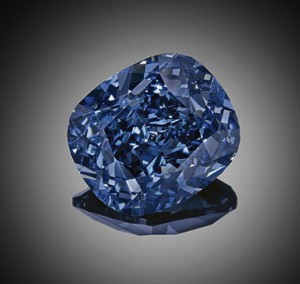
Blue Moon is expected to fetch more than twice the price Laurence Graff paid at Christie’s in 2008 for the 35.56ct deep blue Wittelsbach diamond, cut four centuries earlier. While the Wittelsbach was considerably larger, it didn’t come with the highest color rating by the GIA. After buying the historic diamond for a record-breaking $24.3mil, Graff recut it to repair damage and intensify color, reducing its size and upsetting many who believed the diamond’s history held its own value.
I saw the Wittelsbach-Graff and chatted with Graff and his son in 2010, when their blue coup went on display at the Smithsonian. He was a little defensive about that recutting, as I recall.
Both the Hope and Wittelsbach diamonds were drenched in history and intrigue, unearthed centuries ago from India’s Golconda Mines, then passing through royal hands. The Blue Moon, on the other hand, involves a recent find: a 29.62-carat rough diamond discovered in January 2014 by Petra Diamonds – owners of the Cullinan Mine in South Africa, source of the world’s largest gem diamond ever recovered. The Cullinan diamond (3,106 carats rough) was cut to form the Great Star of Africa and the Second Star of Africa, largest cut diamonds in the British Crown Jewels.
Cullinan Mine is now known as the source for very large, high quality Type II diamonds – meaning no measurable nitrogen impurities, top quality color and clarity. Type IIa diamonds – 1 to 2 percent of all natural diamonds – are almost or entirely devoid of impurities and usually colorless. Many large famous diamonds, such as the Cullinan and the Koh-i-Noor, are Type IIa.
Type IIb, such as the Blue Moon, make up only about 0.1% of all natural diamonds. In addition to having very low levels of nitrogen impurities comparable to Type IIa diamonds, Type IIb diamonds contain significant boron impurities. This is what causes their blue/grey color. All blue diamonds are Type IIb, making them one of the rarest natural diamonds and very valuable.
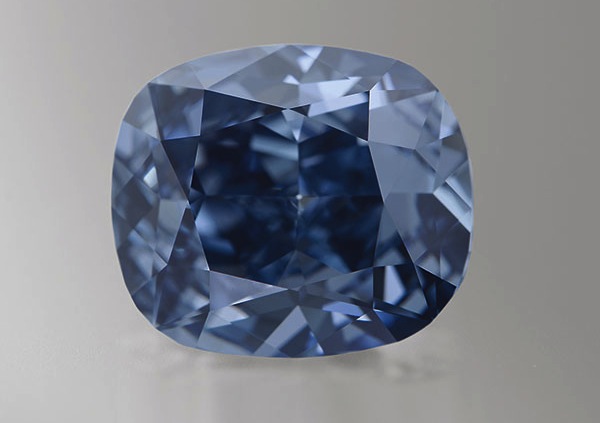
In what has now become standard for multi-million dollar jewels, such as top lots in the Magnificent Jewels sales, Sotheby’s not only devoted a slideshow to the Blue Moon, they produced a teaser video showing the diamond revealed by a flood of water against sounds of a storm. Beautiful, dramatic, but ultimately disappointing. The gem itself doesn’t move! So not only do you miss seeing it from different angles, you don’t see any play of light, that glitter of rainbow spectrum only diamonds produce. Isn’t the point of video to do what still photography can’t? With gems like diamonds and opals that come with their own light show, the promo video is particularly important. Here it is, so you can decide for yourself.
Most colored stones get their color from the presence of a chemical element. Blue sapphire, for example, contains iron and titanium impurities, while the rich color of Paraiba tourmaline comes from copper. Blue diamonds, on the other hand, obtain their color from “color centers” – non-carbon atoms that replace carbon in the structure of the diamond, causing a disturbance. Less than one boron atom per million carbon atoms is enough to produce the blue coloration.
“Blue diamonds are among the rarest of all natural colored diamonds,” said Dr. Eloïse Gaillou, curator and diamond expert at the Natural History Museum of Los Angeles. Gaillou was part of a team that examined the Blue Moon Diamond last year at the Smithsonian Institution. The tests were part of an ongoing mission to uncover the mystery of blue diamonds.
In 2012, I wrote about tests done on the Smithsonian’s other blue diamonds, including the famous Hope, feather in the Institution’s gemological cap. After Graff bought the Wittelsbach, he allowed the museum’s staff to test the diamond for boron content. He was hoping to find his new diamond was cut from the same rough as the Hope. Alas for him, while apparently found nearby, it was not a chip off the old block.
The stone up for sale at Sotheby’s on November 11 would look dwarfed beside the 45.52ct Hope, but it’s still a thrilling eyeful. And it has at least one thing in common with the Hope. Both glow crimson red under ultraviolet light.
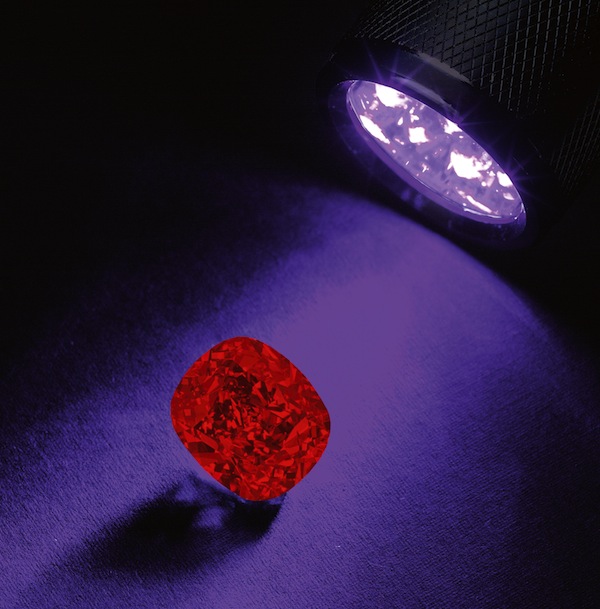
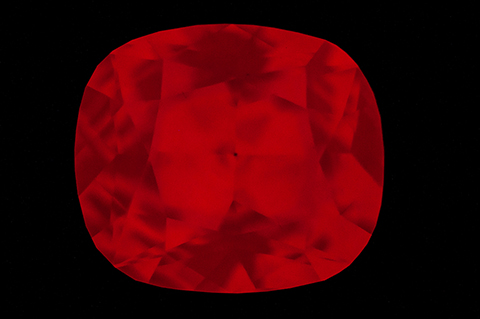

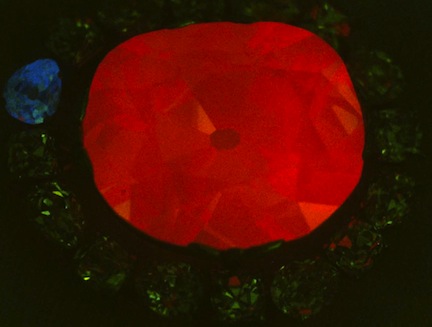
An excerpt from my post Why blue diamonds are blue: recent tests on the Hope Diamond:
Every now and then, the Hope is removed from its display case and its 1910 Cartier setting, then inserted into various high-tech apparatuses, poked, prodded, and irradiated.
But somehow it always defies analysis and ends up back in its showcase, mystery intact. In 2010, for example, when the Hope shared the spotlight with the Wittelsbach, both historic gems were put under the microscope and exposed to infrared light. Both glowed brilliant red under ultraviolet light – though not in quite the same way. This bizarre ability of natural blue diamonds to emit a phosphorescent, glow-in-the-dark red, even after the light is turned off, is a tool gemologists use to separate real blue diamonds from fakes. Due to its particular boron mix, the Hope turns a fiery red. (See more here. )
So, it seems, does the Blue Moon. Only this diamond isn’t going back into a museum case – unless a museum manages to make the winning bid next month. If you want a look at this one, get thee to a Sotheby’s showroom. Prior to its auction at the Magnificent Jewels and Noble Jewels sale in Geneva on November 11, Sotheby’s will exhibit the diamond in:
Hong Kong: October 3-6
London: October 18–22
New York: October 30–November 1
Look for me at that last one!
Photos on this page (except for those supplied by Sotheby’s) are by the late, great gem photographer Tino Hammid

